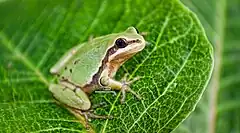| Dryophytes eximius | |||
| (Baird, 1854) | |||
 | |||
| Systematyka | |||
| Domena | |||
|---|---|---|---|
| Królestwo | |||
| Typ | |||
| Podtyp | |||
| Gromada | |||
| Rząd | |||
| Podrząd | |||
| Rodzina | |||
| Podrodzina | |||
| Rodzaj | |||
| Gatunek |
D. eximius | ||
| Synonimy | |||
| |||
| Kategoria zagrożenia (CKGZ)[9] | |||
 | |||
Dryophytes eximius – gatunek płaza bezogonowego z rodziny rzekotkowatych (Hylidae).
Taksonomia
Gatunek posiada liczne synonimy. Do 2001 umieszczano tu też populację uznaną później za gatunek Dryophytes wrightorum, czego dokonał Duellman[9].
Występowanie
Opisywany przedstawiciel bezogonowych występuje jedynie w Meksyku[9][10], będąc endemitem Sierra Madre Zachodniej[9]. Preferuje on wysokości od 910 do 2900 metrów nad poziomem morza[9]. Zasiedla tereny trawiaste, porośnięte mesquite, krzewami, lasem sosnowo-dębowym[9].
Rozmnażanie
Przebiega w środowisku wodnym, w wodach stojących (stawy), jak i w strumieniach o wolnym nurcie[9]. Zwierzęta preferują płytką wodę[9].
Status
Obecnie występują liczne populacje niezagrożone wyginięciem[9]. Całkowita liczebność gatunku nie ulega zmianie[9].
Przypisy
- ↑ S.F. Baird. Descriptions of new genera and species of North American frogs. „Proceedings of the Academy of Natural Sciences of Philadelphia”. 7, s. 61, 1854. (ang.).
- ↑ E.D. Cope. Third contribution to the herpetology of tropical America. „Proceedings of the Academy of Natural Sciences of Philadelphia”. 17, s. 194, 1865. (ang.).
- ↑ F. Mocquard. Contribution a la faune herpetologique de la Basse-Californie. „Nouvelles Archives du Muséum d’Histoire Naturelle”. Quartéme Série. 1, s. 339, 1899. (fr.).
- ↑ E.H. Taylor. Frogs of the Hyla eximia group in Mexico, with descriptions of two new species. „University of Kansas Science Bulletin”. 25, s. 430, 1938. (ang.).
- ↑ K.P. Schmidt: A Check List of North American Amphibians and Reptiles. Wyd. Sixth Edition. Chicago: American Society of Ichthyologists and Herpetologists and University of Chicago Press, 1953, s. 71. (ang.).
- ↑ T.P. Maslin. Hyla microeximia sp. n., Hylidae, Amphibia, from Jalisco, Mexico. „Herpetologica”. 13 (2), s. 81, 1957. (ang.).
- ↑ M.J. Fouquette Jr. & A. Dubois: A Checklist of North American Amphibians and Reptiles. Wyd. Seventh Edition. Cz. 1: Amphibians. Bloomington: XLibris, 2014, s. 331. (ang.).
- ↑ W.E. Duellman, A.B. Marion & S.B. Hedges. Phylogenetics, classification, and biogeography of the treefrogs (Amphibia: Anura: Arboranae). „Zootaxa”. 4104 (1), s. 23, 2016. DOI: 10.11646/zootaxa.4104.1.1. (ang.).
- 1 2 3 4 5 6 7 8 9 10 IUCN SSC Amphibian Specialist Group, Dryophytes eximius, [w:] The IUCN Red List of Threatened Species 2018, wersja 2017-3 [dostęp 2018-01-03] (ang.).
- ↑ IUCN SSC Amphibian Specialist Group, Dryophytes eximius, [w:] The IUCN Red List of Threatened Species [dostęp 2009-12-12] (ang.).